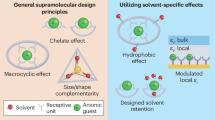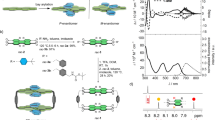Abstract
Halogen bonding (XB), the attractive interaction between an electron-deficient halogen atom and a Lewis base, has undergone a dramatic development as an intermolecular force analogous to hydrogen bonding (HB). However, its utilization in the solution phase remains underdeveloped. Furthermore, the design of receptors capable of strong and selective recognition of anions in water remains a significant challenge. Here we demonstrate the superiority of halogen bonding over hydrogen bonding for strong anion binding in water, to the extent that halide recognition by a simple acyclic mono-charged receptor is achievable. Quantification of iodide binding by rotaxane hosts reveals the strong binding by the XB-rotaxane is driven exclusively by favourable enthalpic contributions arising from the halogen-bonding interactions, whereas weaker association with the HB-rotaxanes is entropically driven. These observations demonstrate the unique nature of halogen bonding in water as a strong alternative interaction to the ubiquitous hydrogen bonding in molecular recognition and assembly.
This is a preview of subscription content, access via your institution
Access options
Subscribe to this journal
Receive 12 print issues and online access
$259.00 per year
only $21.58 per issue
Buy this article
- Purchase on Springer Link
- Instant access to full article PDF
Prices may be subject to local taxes which are calculated during checkout





Similar content being viewed by others
References
Metrangolo, P., Meyer, F., Pilati, T., Resnati, G. & Terraneo, G. Halogen bonding in supramolecular chemistry. Angew. Chem. Int. Ed. 47, 6114–6127 (2008).
Politzer, P., Lane, P., Concha, M. C., Ma, Y. & Murray, J. S. An overview of halogen bonding. J. Mol. Model. 13, 305–311 (2007).
Rissanen, K. Halogen bonded supramolecular complexes and networks. CrystEngComm 10, 1107–1113 (2008).
Roper, L. C. et al. Experimental and theoretical study of halogen-bonded complexes of DMAP with di- and triiodofluorobenzenes. A complex with a very short N···I halogen bond. Cryst. Growth Des. 10, 3710–3720 (2010).
Cinčić, D., Friščić, T. & Jones, W. Isostructural materials achieved by using structurally equivalent donors and acceptors in halogen-bonded cocrystals. Chem. Eur. J. 14, 747–753 (2008).
Liantonio, R., Metrangolo, P., Pilati, T., Resnati, G. & Stevenazzi, A. Perfluorocarbon–hydrocarbon self-assembly: first crystalline halogen-bonded complex involving bromoperfluoroalkanes. Cryst. Growth Des. 3, 799–803 (2003).
Xu, J. et al. Trimeric supramolecular liquid crystals induced by halogen bonds. J. Mater. Chem. 16, 3540–3545 (2006).
Beale, T. M., Chudzinski, M. G., Sarwar, M. G. & Taylor, M. S. Halogen bonding in solution: thermodynamics and applications. Chem. Soc. Rev. 42, 1667–1680 (2013).
Serpell, C. J., Kilah, N. L., Costa, P. J., Félix, V. & Beer, P. D. Halogen bond anion templated assembly of an imidazolium pseudorotaxane. Angew. Chem. Int. Ed. 49, 5322–5326 (2010).
Gilday, L. C. et al. A catenane assembled through a single charge-assisted halogen bond. Angew. Chem. Int. Ed. 52, 4356–4360 (2013).
Sarwar, M. G., Dragisic, B., Salsberg, L. J., Gouliaras, C. & Taylor, M. S. Thermodynamics of halogen bonding in solution: substituent, structural, and solvent effects. J. Am. Chem. Soc. 132, 1646–1653 (2010).
Sarwar, M. G., Dragisic, B., Sagoo, S. & Taylor, M. S. A tridentate halogen-bonding receptor for tight binding of halide anions. Angew. Chem. Int. Ed. 49, 1674–1677 (2010).
Kilah, N. L. et al. Enhancement of anion recognition exhibited by a halogen-bonding rotaxane host system. J. Am. Chem. Soc. 132, 11893–11895 (2010).
Zapata, F. et al. Fluorescent charge-assisted halogen-bonding macrocyclic halo-imidazolium receptors for anion recognition and sensing in aqueous media. J. Am. Chem. Soc. 134, 11533–11541 (2012).
Caballero, A. et al. A halogen-bonding catenane for anion recognition and sensing. Angew. Chem. Int. Ed. 51, 1876–1880 (2012).
Cametti, M. et al. 2-Iodo-imidazolium receptor binds oxoanions via charge assisted halogen bonding. Org. Biomol. Chem. 10, 1329–1333 (2012).
Jentzsch, A. V. et al. Transmembrane anion transport mediated by halogen-bond donors. Nature Commun. 3, 905 (2012).
Kniep, F. et al. Organocatalysis by neutral multidentate halogen-bond donors. Angew. Chem. Int. Ed. 52, 7028–7032 (2013).
Voth, A. R., Hays, F. A. & Ho, P. S. Directing macromolecular conformation through halogen bonds. Proc. Natl Acad. Sci. USA 104, 6188–6193 (2007).
Wilcken, R., Zimmermann, M. O., Lange, A., Joerger, A. C. & Boeckler, F. M. Principles and applications of halogen bonding in medicinal chemistry and chemical biology. J. Med. Chem. 56, 1363–1388 (2013).
Laurence, C., Graton, J., Berthelot, M. & El Ghomari, M. J. The diiodine basicity scale: toward a general halogen-bond basicity scale. Chem. Eur. J. 17, 10431–10444 (2011).
Cabot, R. & Hunter, C. A. Non-covalent interactions between iodo-perfluorocarbons and hydrogen bond acceptors. Chem. Commun. 2005–2007 (2009).
Walter, S. M. et al. Isothermal calorimetric titrations on charge-assisted halogen bonds: role of entropy, counterions, solvent, and temperature. J. Am. Chem. Soc. 134, 8507–8512 (2012).
Smith, D. A., Brammer, L., Hunter, C. A. & Perutz, R. N. Metal hydrides form halogen bonds: measurement of energetics of binding. J. Am. Chem. Soc. 136, 1288–1291 (2014).
Kubik, S. Anion recognition in water. Chem. Soc. Rev. 39, 3648–3663 (2010).
Sessler, J. L., Gale, P. A. & Cho, W-S. Anion Receptor Chemistry (Royal Society of Chemistry, 2006).
Rowe, S. M., Miller, S. & Sorscher, E. J. Cystic fibrosis. N. Engl. J. Med. 352, 1992–2001 (2005).
Delange, F. The disorders induced by iodine deficiency. Thyroid 4, 107–128 (1994).
Pflugrath, J. W. & Quiocho, F. A. Sulphate sequestered in the sulphate-binding protein of Salmonella typhimurium is bound solely by hydrogen bonds. Nature 314, 257–260 (1985).
Luecke, H. & Quiocho, F. A. High specificity of a phosphate transport protein determined by hydrogen bonds. Nature 347, 402–406 (1990).
Spence, G. T. & Beer, P. D. Expanding the scope of the anion templated synthesis of interlocked structures. Acc. Chem. Res. 46, 571–586 (2013).
Collins, C. G., Peck, E. M., Kramer, P. J. & Smith, B. D. Squaraine rotaxane shuttle as a ratiometric deep-red optical chloride sensor. Chem. Sci. 4, 2557–2563 (2013).
Hancock, L. M. et al. Rotaxanes capable of recognising chloride in aqueous media. Chem. Eur. J. 16, 13082–13094 (2010).
White, N. G. & Beer, P. D. A catenane host system containing integrated triazole C–H hydrogen bond donors for anion recognition. Chem. Commun. 48, 8499–8501 (2012).
Hancock, L. M. & Beer, P. D. Chloride recognition in aqueous media by a rotaxane prepared via a new synthetic pathway. Chem. Eur. J. 15, 42–44 (2009).
Hynes, M. J. EQNMR: a computer program for the calculation of stability constants from nuclear magnetic resonance chemical shift data. J. Chem. Soc. Dalton Trans. 2, 311–312 (1993).
Gibb, C. L. D. & Gibb, B. C. in Supramolecular Chemistry: From Molecules to Nanomaterials Vol. 1 (eds Gale, P. A. & Steed, J. W.) 45–66 (Wiley, 2012).
Case, D. A. et al. AMBER 12 (Univ. California, 2012).
Wang, J., Wolf, R. M., Caldwell, J. W., Kollman, P. A. & Case, D. A. Development and testing of a general amber force field. J. Comput. Chem. 25, 1157–1174 (2004).
Wang, J., Wolf, R. M., Caldwell, J. W., Kollman, P. A. & Case, D. A. Development and testing of a general amber force field. J. Comput. Chem. 26, 114 (2005).
Jorgensen, W. L., Chandrasekhar, J., Madura, J. D., Impey, R. W. & Klein, M. L. Comparison of simple potential functions for simulating liquid water. J. Chem. Phys. 79, 926–935 (1983).
Acknowledgements
M.J.L. thanks the Engineering and Physical Sciences Research Council (EPSRC) for a Doctoral Training Account (DTA) studentship. S.W.R. thanks the Clarendon Fund and St. John's College, Oxford, for financial support. I.M. thanks the Fundação para a Ciência e a Tecnologia (FCT) for PhD scholarship SFRH/BD/87520/2012.
Author information
Authors and Affiliations
Contributions
P.D.B. conceived the project. The experimental work was performed mainly by M.J.L., with contributions from S.W.R. towards the synthesis of 1 and 2. I.M. and V.F. conducted the theoretical calculations. All authors contributed to the analysis of the data. M.J.L. and P.D.B. wrote the paper, with assistance from S.W.R. and V.F.
Corresponding author
Ethics declarations
Competing interests
The authors declare no competing financial interests.
Supplementary information
Supplementary information
Supplementary information (PDF 2149 kb)
Rights and permissions
About this article
Cite this article
Langton, M., Robinson, S., Marques, I. et al. Halogen bonding in water results in enhanced anion recognition in acyclic and rotaxane hosts. Nature Chem 6, 1039–1043 (2014). https://doi.org/10.1038/nchem.2111
Received:
Accepted:
Published:
Issue Date:
DOI: https://doi.org/10.1038/nchem.2111
This article is cited by
-
Solvent effects in anion recognition
Nature Reviews Chemistry (2024)
-
Analysis of the host–guest complex formation involving bridged hexameric pyridinium–phenyl rings in the HexaCage6+ host in suit[3]ane: insights from dispersion-corrected DFT calculations for a nanometric mechanically interlocked device
Journal of Nanostructure in Chemistry (2022)
-
An alkali-resistant metal–organic framework as halogen bond donor for efficient and selective removing of ReO4−/TcO4−
Environmental Science and Pollution Research (2022)
-
Dielectric and ferroelectric sensing based on molecular recognition in Cu(1,10-phenlothroline)2SeO4·(diol) systems
Nature Communications (2017)
-
Weakening and Leveling Effect of Solvent Polarity on Halogen Bond Strength of Diiodoperfluoroalkane with Halide
Journal of Solution Chemistry (2017)



